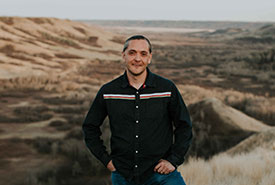Nature as identity

Philip Brass (Photo by Dane Roy)
Connecting with the natural world by listening to its language, Philip Brass serves as an interpreter for the land, helping create a richer understanding between humanity and the environment.
Anishinaabe artist and hunter Philip Brass recalls being four or five years old, trudging behind his father through the Qu’Appelle Valley in Saskatchewan. He can still feel the bulrushes brushing against his body, and the wind whispering through the marshy grasses of the prairie landscape.
“I remember feeling so small, and he was like a giant to me. My eyes were focused on the backs of his legs,” recalls Brass. “We were out hunting. I remember watching ducks fall from the sky and there being a pile by my feet and being fascinated with them. Later, sitting around the fire, we were plucking, cleaning and singeing these ducks. The thick smell of the singed feathers is something that has stuck with me and triggers my memory to this day.”
This bond between father and son can be described using the Cree word Wahkohtowin, which loosely translates to “kinship,” says Brass. The word also describes the ecological relationship humans share with nature and is part of Cree natural laws. “Under Wahkohtowin, we acknowledge that all life — from plants and animals all the way down to the microbial level under the soil — is related,” says Brass. “We respect our interaction with them, the role we play in reciprocity and the relationship we maintain with the ecosystem we inhabit.”
Brass is from the Peepeekisis Cree Nation in Saskatchewan. Here, he works with Indigenous and non-Indigenous youth in and around his community, teaching traditional knowledge and skills for caring for and living off of the land.
Under Wahkohtowin, we acknowledge that all life — from plants and animals all the way down to the microbial level under the soil — is related.
“Every activity we do on the land is undertaken in a prayerful manner, even the act of walking on the land, hunting or gathering medicine — all of it is ceremony. These activities go along with certain teachings.”
Bringing youth onto the land opens up new possibilities for understanding and bonding with one another and with nature, explains Brass.
“Land-based education really gives an opportunity to heal a lot of the social struggles that kids are facing. There might be boys who really didn’t get along at school, but once I get them out on the land, where they have to work together, they soon develop a sense of belonging with one another.”
By connecting youth to the land, Brass is helping to connect them with their culture and its traditional teachings. “My Saulteaux and Cree identity influences how I connect with nature. There are certain spirit beings that inhabit each ecosystem. When I speak Cree, I am speaking the language of the land. Indigenous culture and its existence rely on the existence of the land.”
Brass is now a father of six sons — five of whom are teenagers adopted through a traditional ceremony.
“Our process is a traditional adoption through our cultural practices. These are all boys in my community. Some of them have no father, while others have a loving father in their lives already, but may not have the economic means or cultural knowledge to provide certain opportunities and teachings. I spend a lot of time with them on the land. They become family.”
In a world that is often overwhelmed with screens and social media, Brass is passionate about bringing nature back into the lives of youth. By passing on the knowledge he learned from his father and the generation before his, he is working to close the gap between the natural world and the human one.
“I was privileged enough to be introduced to this way of life,” says Brass. “It’s my responsibility as a father to pass on this deep ecological relationship to my children and community.”





